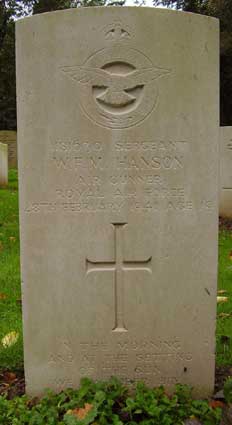Blenheim L1168 near Nether Poppleton.
On the night of 27th / 28th February 1941 the crew of this 54 Operational Training Unit aircraft were undertaking a night training exercise which involved receiving a beacon to home towards while in the air to simulate locating a target upon receiving the location from a ground unit. This exercise was a common one flown during night-fighter training in which 54 OTU were employed to provide. During the exercise the aircraft was flying close to York when the aircraft was illuminated by a search light battery. The pilot was probably blinded or dazzled by the searchlight beam and lost control, he managed to regain control briefly but again lost control or could not see the instrument panel, it went into a dive from which he was able to recover and the aircraft crashed near Nether Poppleton at 00.30hrs. Sadly the two crew died as a result of this incident. Why he was over York was not known but the accident report stated that the searchlight unit had every right to challenge the aircraft.
Pilot - P/O George Reginald Beale-Brown RAFVR (78529), aged 32. Buried Cold Salperton Churchyard, Glocestershire.
Air Gunner - Sgt William Frederick Moore Hanson RAFVR (1181630), aged 19, of Aylesbury, Buckinghamshire. Buried Kirkby Wharfe Cemetery, Yorkshire.
Sgt Hanson's gravestone at Kirkby Wharfe.
George Beale-Browne was born on 1915 and was the son of Major George Augustus and Isobel Beale-Browne. As a young man George attended Charterhouse School and then started a degree course at Pembroke College, Oxford. He left Oxford University in 1934, married and set up home with his wife in Oxford. He became a pilot member of the Oxford and Witney Flying Club in April 1936 and later trained as a flying instructor. He joined the RAFVR before the start of the war and later received a commission to the rank of P/O on 17th April 1940. Notes located by historian Tom Pearson-Chisman was revealed that he served in Iraq and also served as a flying instructor. At the time of his death he is listed as having flown 1600 hours as pilot and some of these flying hours must relate to his civilian flying. Whether he served as an RAF flying instructor or as a civilian employed to give initial training to RAF recruits is not yet known (basic training units such as E.F.T.S.'s employed civilians and service flying instructors and he may have been one of these civilians employed for such duties). He also had around 250 hours of night fying to his name (but only a handful in Blenheims) and was clearly no novice pilot when he was killed in the crash near Nether Poppleton.

Blenheim L1168 was built to contract 517114/36 by The Bristol Aeroplane Company Ltd at Filton as a bomber variant and was awaiting collection
in March 1939. After a very lengthy period of MU storage it was taken on charge by 18 Squadron at Upper Heyford in May 1939 when the unit converted
from Hind's to Blenheim's. In February 1940 18 Squadron converted to Blenheim MkIV's and L1168 was placed in MU storage where it was converted to
a MkIf configuration. It had a very short stay with 64 Squadron at Church Fenton during March and April 1940 but when 64 Squadron converted to
Spitfire's and the aircraft passed into the hands of 219 Squadron at Catterick. On 3rd July 1940 it was damaged in the starboard engine and fuel tank when it was attacked by Spitfires while on a patrol. On 5th August 1940 it sustained Cat.R/FA damage when it's
undercarriage was damaged on take off at Catterick and on return the then pilot was forced to make a belly landing. From here it was taken away
by road and repaired in works, then followed a period of MU storage before it was taken on charge by 54 OTU at Church Fenton soon after the unit formed
on 25th November 1940. Cat.E2/FA damage was recorded after the accident near York on 28th February 1941 as stated above.